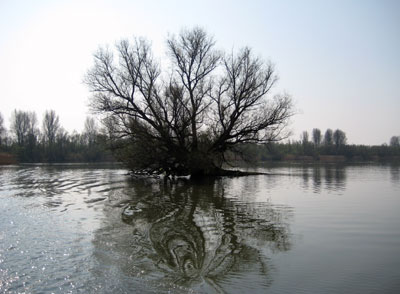
During the last six month, the discussion on the cutting off trees next to Dutch N-roads, provincial roads, was intensified. It started as a ‘soft’ rule in the ‘Handboek Wegontwerp 2013’ which was published by the knowledge platform CROW, which stated that a tree should be planted away from the road for at least four and a half meters. But it escalated in a question list and discussion on ‘dangerous’ provincial roads by the ANWB (which actually was filled in by only a small group of its members). Many of these ‘dangerous’ roads are flanked by rows of old trees or these roads are in the midst of natural reserved areas. It was argumented that these roads and especially the trees next to it are leading to more injuries and deaths by car accidents. A group called ‘Knights of Trees’ (Bomenridders) collected –with success- many thousands of signatures of worried people, fearing the cutting of trees on large scale in the province of South Holland. But this fear is not over yet!
Cutting Trees a Solution?
No doubt that every death or traffic injury is one to many and this should be prevented. Traffic safety is of great importance to us all. But the question rises if downing rows of trees, even 200 or 300 years old trees, is the solution? Of course, it is very pitiful when a car loses control and crashes against a tree. But what would be the consequences if, because all trees in the middle of the road (parkway) were cut off, a troubled car is ending up at the other side of the road facing the oncoming vehicles? What would happen if a group of biking youngsters on the biking lane next to the road would be driven over because of the lack of a row of trees to safeguard them? Is it not the displacement of another problem? Is the basis of the traffic problems this long row of beautiful trees or do we need to take a closer look at specific, dangerous spots? And is the tree, which is standing on the same spot in all cases the most guilty party or do other factors, not at the least the way people drive, play a much more decisive role? The research of the ANWB didn’t answered all of these questions in their story.

Ecology and Environmental Issues
Traffic safety is one of the users arguments. But there are many more arguments not to cut off trees, which should be taken into account every time when is decided if a tree should be cut off or not. First and foremost, trees play a crucial role in the ecology and environmental issues of an area. Trees contribute of course in the production of oxygen (trees are most effective when they are a little older), are cooling the air in the summer and reduce wind and storms and make people more relaxed. Next to this, trees are housing birds, bats and other animals and smaller plants. And they have a function in reducing noise and fine dust, humans bad ‘habits’. Although the ecological and value cannot be named in euro’s, images of the thick smog of Beijing show how things can go wrong with fine dust. Next to this, world leaders- we- have decided this weekend, that our planet should not heat up more than ‘really less than 2 degrees’ in the future. We need all the help –however small- to make it to our climate goal targets and every tree is helping.
Identity and Cultural History
Trees are contributing to the regional landscape identity and cultural history of the place and this should be an argument in the discussion as well. Because trees, individually planted or in rows, which we call avenues or alleys, are part of the history of our cultural landscapes. They play an essential role in the character and identity and branding of a specific area. Many people are thinking now, so what? But landscapes with incensed avenues and forests, like on the boarders of the Veluwe, are being appreciated higher than open, flat landscapes with few trees by tourists, visitors and owners. And happy tourists and visitors are drinking more coffee and tea, staying overnight and shop and therefore, contribute to local economy. And this is leading to more functions for residents and higher house prices, which was shown in the clear graphics and numbers in the ‘Gemeenteatlas 2015’.
And the beauty is not only in the presence, but also in its size, which cannot be restored easily and quickly. When a part of the city is restored, like Utrecht is doing, the process will take 10-15 years. If an old tree needs to be replaced with another rather big one, it takes much more effort to do so. In the Netherlands there is a saying; Tree big, planter dead! (Boom groot, plantertje dood!).
Lost Beauty
Meanwhile, many trees and avenues have lost so much quality already. Recent research at the chair of Landscape Architecture at Delft University of Technology shows figures on the avenues in the Renkum community, a municipality on the boarders of the Veluwe. Over the past 140 years the presence of avenues diminished heavily. While Renkum had 140 different avenues or alleys in 1870, only 40% of these avenues were still intact in 2013. The quality of these avenues has diminished even further. While in 1870 65% of the avenues were still intact, in 2013 only 20% of the avenues were still in good condition. These are just a few numbers of what has happened, but you can already imagine how the appearance and quality of this area has been altered by the loss of the previously present avenues.
Future Driving
The timing is so to say a little wry in this period of time, when specialists are testing systems for cars to drive safely on roads in a ‘super-cruise control mode’ on long distances, which we saw on the news a couple of month ago.So, trees cannot drive cars, but people can. Let’s find specific solutions in which cars can drive safely and trees can stand next to the side of the road.
Hereby, I want to thank Lotte Dijkstra, Karen Cubells, Michiel Pouderoijen en Frits van Loon for their contribution to the blog.
More readings and links:
– Blog of Piet Vollaard ‘Kappen met kappen’ on Archined (11-11-2015): https://www.archined.nl/2015/11/kappen-met-kappen/
– Knights of Trees, site of Rotterdam: www.bomenridders.nl and site to the IJsselsteijnse Knight of Trees: http://www.bomenridders-ijsselstein.nl/dreigende-bomenkap-langs-provinciale-wegen/
– Manual of CROW: http://www.crow.nl/vakgebieden/verkeer-en-vervoer/wegontwerp/vraag-en-antwoord?page=1&searchsort=sco
– Research on the Changing Quality of Lanes in Renkum by C.M. Dijkstra, K. Cubells Guillen, G. Verschuure-Stuip will be published soon.




looking forward to see the full research!